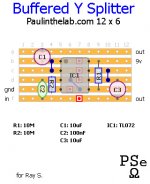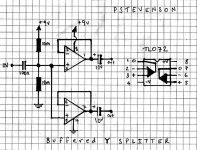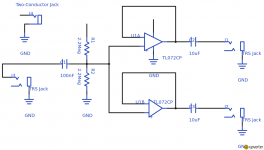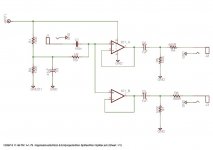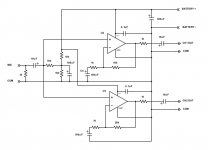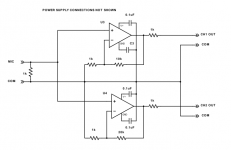hello, please help me design a very simple splitter/buffer
i have available 1 ic, which is the op07
and some transistors listed below:
2N5088
550C
S8050
ST85500
K732c945
S9014
S9015
KN2222A
C2398
C2236A
COSMO1010/817/H38
A1267
C3199
C945P
TL431
must be fed by a 9vdc suppy or battery, 1 input / 2 isolated outputs, the least components needed the better... it also wouldnt hurt if this splitter could be low noise/microphonics or the closest possible;
if the design boosts the signal thats acceptable, although not required since the main feature of this project is to simply split the microphone signal into two isolated outputs
thanks in advance
i have available 1 ic, which is the op07
and some transistors listed below:
2N5088
550C
S8050
ST85500
K732c945
S9014
S9015
KN2222A
C2398
C2236A
COSMO1010/817/H38
A1267
C3199
C945P
TL431
must be fed by a 9vdc suppy or battery, 1 input / 2 isolated outputs, the least components needed the better... it also wouldnt hurt if this splitter could be low noise/microphonics or the closest possible;
if the design boosts the signal thats acceptable, although not required since the main feature of this project is to simply split the microphone signal into two isolated outputs
thanks in advance
Last edited:
i've digged up some schematics for references... i've liked this paulinthelab design and the pstevenson... both very simple, yet too generic for me to formalize on this bases
... awaiting replies, thanks
... awaiting replies, thanks
Attachments
Generally, one microphone can drive two microphone inputs without significant trouble. You just need a Y-connector. With XLR cords, this would usually be a box with three XLRs, one for the mike and two for the two preamps. Inside you just wire all same-number contacts together.
Generally, one microphone can drive two microphone inputs without significant trouble. You just need a Y-connector. With XLR cords, this would usually be a box with three XLRs, one for the mike and two for the two preamps. Inside you just wire all same-number contacts together.
if you say so, i could give it a try, but i'd tell ya something:
1- i plan to plug one mic into two different amps, the mic is p10, as everything else involved in this subject... one amplifier is a tube amp, the other is a mosfet... is it 100% safe? theres no risk of signal bleeding from one amp to another, resulting in bad audio quality or further damage on equipment?
2- if the answer of #1 is positive/safe, theres still one little concern: its not viable for me to direct plug the microfone into the amplifier (s) because the signal is weak and i usually plug the mic into a guitar pedal to boost the signal and benefit from more audible amplification with less microphonics, so in the end, looks like the isolated splitter seems to be necessary as far as i know, but maybe i'm wrong, who knows?
yet, i have an y plug here laying around anyway, but i dont feel its a good idea, at least for guitar it wouldnt work in a professional way, but maybe the microphones act different... please say more about it
Last edited:
its not viable for me to direct plug the microfone into the amplifier (s) because the
signal is weak and i usually plug the mic into a guitar pedal to boost the signal
If the mic needs gain before going to the amp, then you do need a gain stage.
One gain stage can drive both of your amps at the same time if you want.
You can also use two separate gain stages, maybe with different gains to suit each amp.
Both gain stages can be connected to the same mic at the same time.
Last edited:
If the mic needs gain before going to the amp, then you do need a gain stage.
One gain stage can drive both of your amps at the same time if you want.
You can also use two separate gain stages, maybe with different gains to suit each amp.
Both gain stages can be connected to the same mic at the same time.
it could be done, yes, and it would spare me from using my turbo rat on the mics lol, but would it be simple to build compared to an isolated splitter? could it be done with the trannys / ic listed above?
would it be simple to build compared to an isolated splitter? \
Fairly simple, here's the idea. The two outputs can have different gains.
Attachments
Last edited:
Fairly simple, here's the idea. The two outputs can have different gains.
i will try it with the IC OP07 because i have it here... (it came stock with the turbo rat, then i've swapped a lm308n in the rat pedal)
but i think i might need to go buy some resistors and electrolytics... tomorrow i'll see if i have any of those in my pile of junk that i used to pick up in the streets to salvage components, so if i need to go shop anyway, then i might buy a better IC if recommended;
as a personal taste, i avoid electrolytics as much as i can and always look forward to stick into designs with lowest capacitance needed, if theres an alternative to decrease capacitance in this project i'd appreciate, but i'll try to build it as you suggested anyway
for now i thank you and i'll update here the results or if i have any idea to upgrade the design i'll also state here
best wishes
i avoid electrolytics as much as i can and always look forward to stick into designs
with lowest capacitance needed.
If you can use a bipolar power supply (+V/0V/-V) then you can avoid all the electrolytics.
With a single supply or battery, you have to use them, as the values needed are large.
If you use battery power, you could use two of them to make a bipolar supply.
The OP07 should be good for this circuit. Here's the bipolar version of the circuit.
You must use a low input offset voltage op amp for this one, and the OP07 is ok.
Attachments
Last edited:
If you can use a bipolar power supply (+V/0V/-V) then you can avoid all the electrolytics.
With a single supply or battery, you have to use them, as the values needed are large.
If you use battery power, you could use two of them to make a bipolar supply.
The OP07 should be good for this circuit. Here's the bipolar version of the circuit.
You must use a low input offset voltage op amp for this one, and the OP07 is ok.
woah, much thanks! i always use cheap carbon batteries on pedals, at least for guitar... i'll try both alkaline and carbon to see what happens on designs for microphones
Last edited:
i always use cheap carbon batteries on pedals, at least for guitar...
i'll try both alkaline and carbon to see what happens on designs for microphones
Make sure you use batteries larger than the minimum stated in the data sheet.
For the OP07 you need at least 3V/0V/-3V for bipolar, or 6V/0V for single supply.
I would use 100uF capacitors in parallel with each battery (after the power switch).
- Status
- This old topic is closed. If you want to reopen this topic, contact a moderator using the "Report Post" button.
- Home
- Live Sound
- Instruments and Amps
- simple splitter (ic/tranny buffer) for microphone
